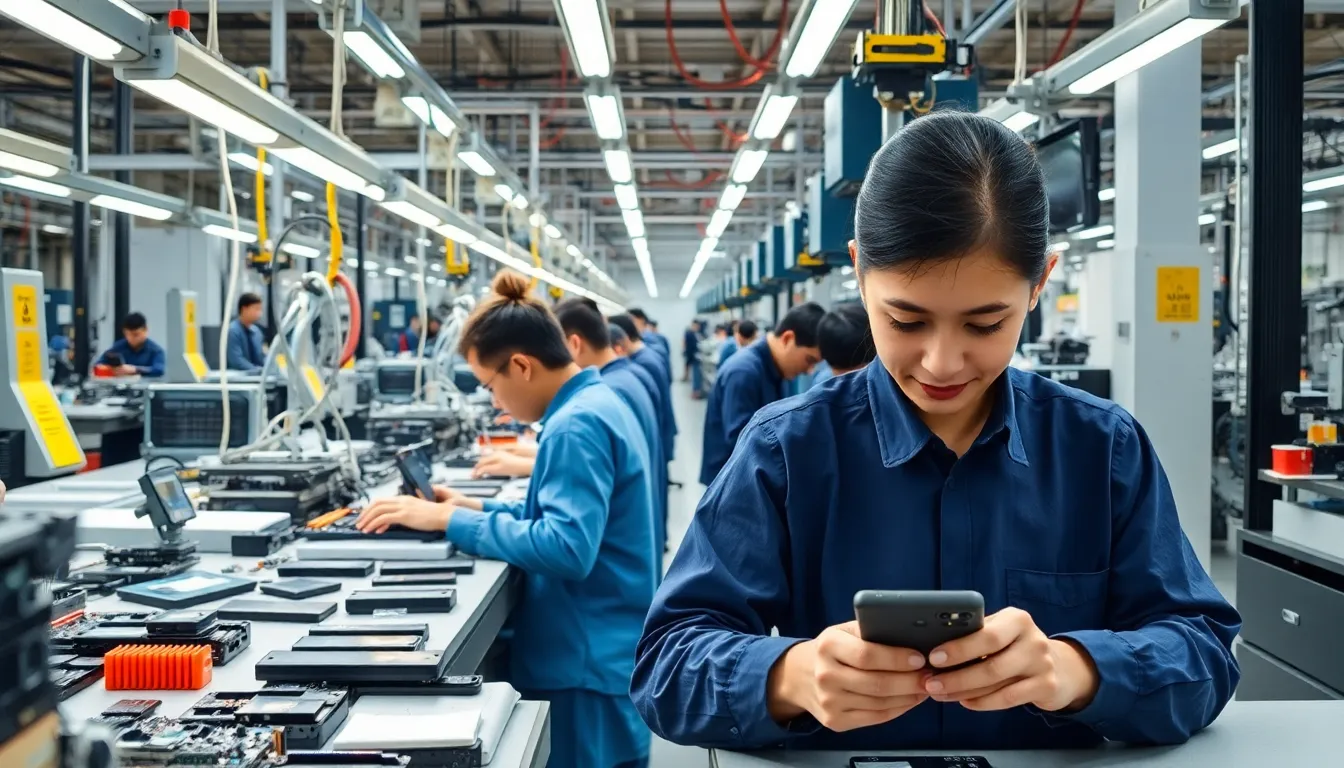Pixel phones have taken the smartphone world by storm, but have you ever wondered where these sleek devices come from? Spoiler alert: it’s not just a magical land where tech wizards sprinkle fairy dust on components. Instead, the journey of a Pixel phone is a fascinating blend of high-tech factories and global collaboration.
Table of Contents
ToggleOverview of Pixel Phones
Pixel phones represent Google’s flagship smartphone line. Designed with an emphasis on advanced technology and user experience, these devices feature high-quality cameras and integrated software.
Manufacturing takes place in various locations worldwide, primarily in Asia. Factories in countries like China, Vietnam, and Taiwan play crucial roles in assembling components. Skilled workers in these regions contribute their expertise to ensure quality and efficiency.
Components sourced from multiple global suppliers enhance the capabilities of Pixel phones. Displays from manufacturers in Japan, processors from companies based in the United States, and camera modules from specialized firms in Europe are just a few examples. This international collaboration ensures each device benefits from cutting-edge advancements.
Google’s commitment to innovation drives the design process behind Pixel phones. Engineers focus on creating user-friendly interfaces and optimizing performance. Regular software updates enhance functionality, keeping devices relevant long after their release.
Each new model reflects evolving consumer needs and technological progress. Reviews often highlight features like voice recognition and artificial intelligence capabilities that set Pixel phones apart. Quality assurance processes ensure that every unit meets stringent standards before reaching consumers.
Pixel phones symbolize the intersection of technology, design, and international collaboration. Their production journey is a testament to the commitment of numerous teams working together to deliver exceptional user experiences.
History of Pixel Phones Production

The production journey of Pixel phones reflects a blend of innovation and strategic planning. Understanding where these devices are made provides insight into their quality and assembly.
Initial Manufacturing Locations
Initial manufacturing primarily took place in China, where skilled workers excel in assembling intricate components. Factories in China contributed significantly to the first generations of Pixel phones, ensuring high standards of craftsmanship. Workers in Taiwan also played key roles, particularly in producing essential parts like circuit boards. Meanwhile, Vietnam emerged as an additional manufacturing site, enhancing production capacity and reducing costs.
Shift in Production Strategies
Shifts in production strategies have manifested in response to global market demands and geopolitical factors. Google expanded its manufacturing footprint to Vietnam and India, aiming to diversify sourcing and mitigate supply chain risks. This strategic shift allowed for greater flexibility in meeting customer needs while maintaining efficiency. Adapting to changes in trade policies and tariffs prompted this transition, enabling access to a broader labor pool. As production strategies evolve, Google remains committed to ensuring quality across all manufacturing locations.
Current Manufacturing Locations
Pixel phones benefit from a diverse manufacturing landscape. Production sites span several countries, primarily in Asia, ensuring an efficient and high-quality assembly process.
Assembly Plants
Key assembly plants for Pixel phones are located in China, Vietnam, and Taiwan. Skilled workers in China excel at assembling intricate components. Vietnam has become crucial as a manufacturing site, enhancing production capacity and reducing costs. Taiwan specializes in creating essential circuit boards that support the overall functionality of the devices. Each location plays a vital role in the final assembly, contributing to the quality and efficiency of Pixel phones.
Major Production Partners
Major production partners include several international suppliers. Displays come primarily from Japan, known for advanced display technology. Processors sourced from the U.S. enhance performance and speed. Camera modules produced in Europe contribute superior imaging capabilities. This collaborative effort ensures that each Pixel phone showcases cutting-edge technology and meets high standards of quality. Global partnerships enable Google to optimize its supply chain while ensuring consistent innovation across all models.
Impact of Manufacturing Locations
Manufacturing locations significantly influence the production quality and cost of Pixel phones. Several factors come into play, particularly regarding quality control and economic considerations.
Quality Control Measures
Quality control measures play a vital role in maintaining the reputation of Pixel phones. Each assembly plant implements strict testing protocols, ensuring that every component meets high standards. Workers in China meticulously inspect intricate parts before assembly. Vietnam contributes through efficient processes that enhance overall product quality. Regular audits verify compliance with international quality standards. Additionally, partnership with suppliers across multiple regions guarantees access to premium materials, supporting exceptional final products.
Economic Considerations
Economic considerations impact the production strategy of Pixel phones. Labor costs in Vietnam and China allow for competitive pricing without compromising quality. Increased production capacity in Vietnam enables Google to meet global demand effectively. Risk mitigation becomes a priority as geopolitical factors affect supply chains. Diversification into India further reduces reliance on a single region, promoting stability. Overall, these economic factors align with Google’s long-term goals and market positioning, fostering growth in an ever-evolving tech landscape.
Future of Pixel Phone Manufacturing
Shifts in Pixel phone manufacturing may reshape the industry landscape. As Google continues to diversify its production, increased focus on sustainability becomes crucial. Plans for utilizing eco-friendly materials in devices signal a commitment to environmental responsibility. Adopting such practices can enhance brand loyalty among consumers concerned about their ecological footprint.
Emerging technologies play a significant role in future manufacturing processes. Automation and artificial intelligence promise to increase efficiency and reduce production costs. These advancements enable Google to maintain high standards of quality while adapting to changing market demands. Innovations in supply chain management also enhance responsiveness to global trends.
Expanding production capabilities in India presents unique opportunities. The Indian market provides a growing consumer base supportive of international technology brands. Manufacturing in India can further mitigate risks associated with geopolitical uncertainties in other regions. Increased investment in local facilities fosters skill development, benefiting the broader economy.
Collaboration with local partners offers strategic advantages. Companies in India can provide specialized services, enhancing overall production efficiency. Access to local resources can reduce lead times, ensuring timely product launches. Leveraging native talent supports the creation of customized solutions tailored to regional preferences.
Consumer engagement remains a priority for Google. Feedback from users can guide future design and manufacturing processes. Incorporating consumer insights ensures that Pixel phones evolve alongside technological advances and user expectations. This approach solidifies the brand’s position as a leader in the competitive smartphone market.
The future of Pixel phone manufacturing hinges on innovation, sustainability, and strategic collaborations. By embracing these elements, Google continues to push boundaries in technology while delivering high-quality products to consumers worldwide.
The manufacturing journey of Pixel phones reflects a blend of global expertise and innovation. By leveraging resources from various countries Google not only enhances product quality but also adapts to changing market dynamics. The strategic shift in production locations signifies a proactive approach to supply chain management.
As Google continues to prioritize sustainability and technological advancements the future of Pixel phone manufacturing looks promising. Engaging with local partners and incorporating user feedback ensures that these devices remain relevant and competitive. Overall the commitment to quality and collaboration underlines the significance of Pixel phones in the smartphone landscape.



